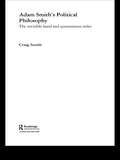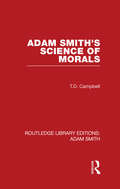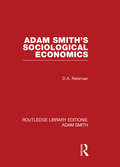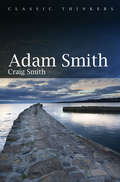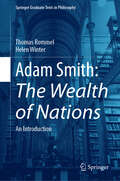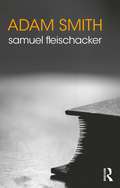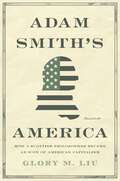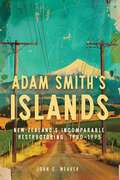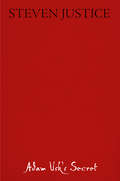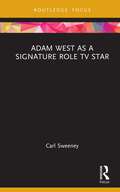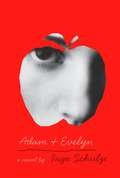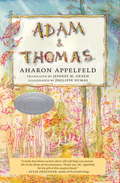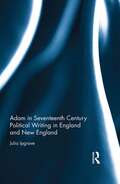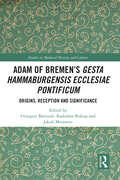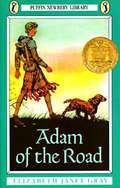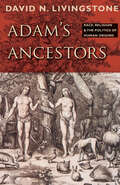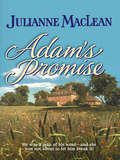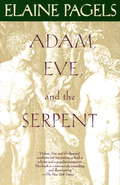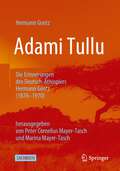- Table View
- List View
Adam Smith's Political Philosophy: The Invisible Hand and Spontaneous Order (Routledge Studies in Social and Political Thought #Vol. 42)
by Craig SmithWhen Adam Smith published his celebrated writings on economics and moral philosophy he famously referred to the operation of an 'invisible hand'. Adam Smith’s Political Philosophy makes visible this hand by examining its significance in Smith’s political philosophy and relating it to similar concepts used by other philosophers, thus revealing a distinctive approach to social theory that stresses the importance of the unintended consequences of human action. The first book to examine the history of Smith’s political philosophy from this perspective, this work introduces greater conceptual clarity to the discussion of the invisible hand and the related notion of unintended order in the work of Smith, as well as in political theory more generally. By examining the application of spontaneous order ideas in the work of Smith, Hume, Hayek and Popper, this important volume traces similarities in approach, and from these constructs a conceptual, composite model of an invisible hand argument. While setting out a clear framework of the idea of spontaneous order, the book also builds the case for using this as an explanatory social theory, with chapters on its application in the fields of science, moral philosophy, law and government.
Adam Smith's Science of Morals (Routledge Library Editions: Adam Smith)
by Tom CampbellThis critical exposition of Adam Smith’s Theory of Moral Sentiments, first published in 1971, gives an appreciation of Smith’s conception of scientific method as applied to the study of social phenomena. The work is placed in the context of Smith’s other writings including of course The Wealth of Nations, but making special use of the theory of scientific development contained in his posthumous work, Essays on Philosophical Subjects. By concentrating on Smith’s methodological approach to the study of society, this book provides an illuminating interpretation of his moral theory and defends it against any mistaken criticisms. It also includes a much needed analysis of the important differences between Smith’s ‘impartial spectator’ and the ‘ideal observer’ of modern ethical society. The result is a pointed study, bringing out the close connection between his moral, legal and ethical theories, which will be welcomed by all students of 18th century thought, specialists in moral theory, and the interested lay-reader.
Adam Smith's Sociological Economics (Routledge Library Editions: Adam Smith)
by David Alexander ReismanFirst published in 1976, this book provides an interdiciplinary study fo the thoughts of Adam Smith, showing it particular how the link between economic basis and social superstructure was central to his work. The work is split into six sections, dividing Smith's views along the following lines: 'methology', 'conduct and character', 'consumer behaviour', 'the upper classes', 'the lower classes', and finally 'the State'.
Adam Smith: A Primer (Classic Thinkers)
by Craig SmithAlmost everyone has heard of Adam Smith, founding father of modern economics and author of Wealth of Nations. There is, however, much more to him than this. This new introduction gives a crystal clear overview of the entirety of Smith’s thought. It demonstrates how Smith’s economic theories fit into a larger system of thought that encompasses moral philosophy, philosophy of science, legal and political theory, and aesthetics. Examining the central arguments of his major works, ranging from The Theory of Moral Sentiments to his lectures on jurisprudence and beyond, Smith’s thought is explained in its full intellectual and historical context. As the book unfolds, the long-standing caricature of Adam Smith as an uncritical defender of capitalism red in tooth and claw is systematically challenged, revealing a far more complex and nuanced figure whose rich legacy remains highly relevant today. Comprehensive yet concise, this book will be the leading introduction to Adam Smith’s ideas for generations of students, scholars and general readers, relevant to areas ranging from philosophy and the history of economic thought to political theory.
Adam Smith: An Enlightened Life
by Nicholas PhillipsonAdam Smith is celebrated all over the world as the author of The Wealth of Nations and the founder of modern economics. A few of his ideas - that of the 'Invisible Hand' of the market and that 'It is not from the benevolence of the butcher, the brewer, or the baker that we expect our dinner, but from their regard to their own interest' - have become icons of the modern world. Yet Smith saw himself primarily as a philosopher rather than an economist, and would never have predicted that the ideas for which he is now best known were his most important. This book, by one of the leading scholars of the Scottish Enlightenment, shows the extent to which The Wealth of Nations and Smith's other great work, The Theory of Moral Sentiments, were part of a larger scheme to establish a grand 'Science of Man', one of the most ambitious projects of the European Enlightenment, which was to encompass law, history and aesthetics as well as economics and ethics.Nicholas Phillipson reconstructs Smith's intellectual ancestry and formation, of which he gives a radically new and convincing account. He shows what Smith took from, and what he gave to, the rapidly changing and subtly different intellectual and commercial cultures of Glasgow and Edinburgh as they entered the great years of the Scottish Enlightenment. Above all he explains how far Smith's ideas developed in dialogue with those of his closest friend, the other titan of the age, David Hume. This superb biography is now the one book which anyone interested in the founder of economics must read.
Adam Smith: An Introduction (Springer Graduate Texts in Philosophy)
by Helen Winter Thomas RommelThis textbook provides an accessible introduction to Adam Smith, one of the most important economic thinkers. His seminal work The Wealth of Nations is a classic text in philosophy, social sciences and economics. This introduction puts Smith&’s central ideas on the division of labour, the invisible hand and the market into context. A careful analysis of key passages from Smith&’s writings explains how he arrived at a theory of society and the market that has become central to our understanding of human motives. The discussion of Smith&’s The Wealth of Nations is followed by sources from the 18th century that shaped Smith&’s analysis of human motives and propensities. This introduction is indispensable reading for an informed discussion of the mechanisms that govern human society. It provides an introduction to Adam Smith as one of the most astute thinkers of the 18th century, whose ideas shape modern concepts of the market, making it ideal as course material in courses such as economics, history, political sciences, sociology, literary studies, philosophy.
Adam Smith: Father of Economics
by Jesse NormanA dazzlingly original account of the life and thought of Adam Smith, the greatest economist of all time Adam Smith (1723-1790) is now widely regarded as the greatest economist of all time. But what he really thought, and the implications of his ideas, remain fiercely contested. Was he an eloquent advocate of capitalism and individual freedom? A prime mover of "market fundamentalism"? An apologist for human selfishness? Or something else entirely? In Adam Smith, political philosopher Jesse Norman dispels the myths and caricatures, and provides a far more complex portrait of the man. Offering a highly engaging account of Smith's life and times, Norman explores his work as a whole and traces his influence over two centuries to the present day. Finally, he shows how a proper understanding of Smith can help us address the problems of modern capitalism. The Smith who emerges from this book is not only the greatest of all economists but a pioneering theorist of moral philosophy, culture, and society.
Adam Smith: The Adam Smith Review, Volume 5: Essays Commemorating The 250th Anniversary Of The Theory Of Moral Sentiments (The Routledge Philosophers #5)
by Samuel FleischackerAdam Smith (1723–1790) is widely regarded as one of the great thinkers of the Enlightenment period. Best-known for his founding work of economics, The Wealth of Nations, Smith engaged equally with the nature of morality in his Theory of Moral Sentiments. He also gave lectures on literature and jurisprudence, and wrote papers on art and science. In this outstanding philosophical introduction Samuel Fleischacker argues that Smith is a superb example of the broadly curious thinkers who flourished in the Enlightenment—for whom morality, politics, law, and economics were just a few of the many fascinating subjects that could be illuminated by naturalistic modes of investigation. After a helpful overview of his life and work, Fleischacker examines the full range of Smith’s thought, on such subjects as: epistemology, philosophy of science, and aesthetics the nature of sympathy moral approval and moral judgement virtue religion justice and jurisprudence governmental policy economic principles liberalism. Including chapter summaries, suggestions for further reading, and a glossary, Adam Smith is essential reading for those studying ethics, political philosophy, the history of philosophy, and the Enlightenment, as well as those reading Smith in related disciplines such as economics, law, and religion.
Adam Smith’s America: How a Scottish Philosopher Became an Icon of American Capitalism
by Glory M. LiuThe unlikely story of how Americans canonized Adam Smith as the patron saint of free marketsOriginally published in 1776, Adam Smith&’s The Wealth of Nations was lauded by America&’s founders as a landmark work of Enlightenment thinking about national wealth, statecraft, and moral virtue. Today, Smith is one of the most influential icons of economic thought in America. Glory Liu traces how generations of Americans have read, reinterpreted, and weaponized Smith&’s ideas, revealing how his popular image as a champion of American-style capitalism and free markets is a historical invention.Drawing on a trove of illuminating archival materials, Liu tells the story of how an unassuming Scottish philosopher captured the American imagination and played a leading role in shaping American economic and political ideas. She shows how Smith became known as the father of political economy in the nineteenth century and was firmly associated with free trade, and how, in the aftermath of the Great Depression, the Chicago School of Economics transformed him into the preeminent theorist of self-interest and the miracle of free markets. Liu explores how a new generation of political theorists and public intellectuals has sought to recover Smith&’s original intentions and restore his reputation as a moral philosopher.Charting the enduring fascination that this humble philosopher from Scotland has held for American readers over more than two centuries, Adam Smith&’s America shows how Smith continues to be a vehicle for articulating perennial moral and political anxieties about modern capitalism.
Adam Smith’s Islands: New Zealand’s Incomparable Restructuring, 1980–1995
by John C. WeaverMany developed countries restructured relations between state and economy from the late 1970s into the 1990s. Among them, New Zealand went far, fast, and left a clear trail, making it possible to study economic restructuring as it occurred, with all the debates, uncertainty, surprises, mistakes, and accomplishments this entailed. Adam Smith’s Islands reveals the inside life of a government determined to revolutionize its nation’s politics and economy.While the 1980s economic restructuring of members of the Organisation for Economic Co-operation and Development and former Warsaw Pact countries can seem like a foregone conclusion from the vantage point of the twenty-first century, John Weaver examines how local and global institutions had to come together to implement social adjustments in New Zealand. Mounting evidence that the state had not functioned as an effective manager split the business community and primary producers between defenders of subsidization and free-market insurgents. Reforms undertaken by the governing Labour Party included abandoning currency controls, privatizing state-run businesses, ending a multitude of open and disguised subsidies, tightening fiscal responsibility, and reforming taxation. Adam Smith’s Islands focuses on the verifiable: direct primary sources from dozens of state collections and deposits of personal papers. The archival cornucopia informing this history supports a narrative that has little in common with intellectual histories of neoliberalism. To understand how the relationship between the economy and the state changed, we need to grasp how and why core institutions, practices, and cultural beliefs shed some of their once potent legitimacy.Through the lens of New Zealand, Adam Smith’s Islands examines larger questions about policy dilemmas, the global flow of capital, and the sustainability of social adjustments in economic restructuring. In so doing, it casts new light on the formation and history of what is casually labelled today as the neoliberal state.
Adam Smith’s Pragmatic Liberalism: The Science of Welfare
by Lisa HillAdam Smith is commonly conceived as either an economist or a moral philosopher so his importance as a political thinker has been somewhat neglected and, at times, even denied. This book reveals the integrated, deeply political project that lies at the heart of Smith’s thought, showing both the breadth and novelty of Smith’s approach to political thought. A key argument running through the book is that attempts to locate Smith on the left-right spectrum (however that was interpreted in the eighteenth century) are mistaken: his position was ultimately dictated by his social scientific and economic thought rather than by ideology or principle. Through examining Smith’s political interests and positions, this book reveals that apparent tensions in Smith's thought are generally a function of his willingness to abandon, not only proto-liberal principles, but even the principles of his own social science when the achievement of good outcomes was at stake. Despite the common perception, negative liberty was not the be-all and end-all for Smith; rather, welfare was his main concern and he should therefore be understood as a thinker just as interested in what we would now call positive liberty. The book will uniquely show that Smith’s approach was basically coherent, not muddled, ad hoc, or ‘full of slips’; in other words, that it is a system unified by his social science and his practical desire to maximise welfare.
Adam Usk's Secret
by Steven JusticeAdam Usk, a Welsh lawyer in England and Rome during the first years of the fifteenth century, lived a peculiar life. He was, by turns, a professor, a royal advisor, a traitor, a schismatic, and a spy. He cultivated and then sabotaged figures of great influence, switching allegiances between kings, upstarts, and popes at an astonishing pace. Usk also wrote a peculiar book: a chronicle of his own times, composed in a strangely anxious and secretive voice that seems better designed to withhold vital facts than to recount them. His bold starts tumble into anticlimax; he interrupts what he starts to tell and omits what he might have told. Yet the kind of secrets a political man might find safer to keep--the schemes and violence of regime change--Usk tells openly. Steven Justice sets out to find what it was that Adam Usk wanted to hide. His search takes surprising turns through acts of political violence, persecution, censorship--and, ultimately, literary history. Adam Usk's narrow, eccentric literary genius calls into question some of the most casual and confident assumptions of literary criticism and historiography, making stale rhetorical habits seem new. Adam Usk's Secret concludes with a sharp challenge to historians over what they think they can know about literature and to literary scholars over what they think they can know about history.
Adam West as a Signature Role TV Star (Routledge Focus on Television Studies)
by Carl SweeneyThis book proposes the ‘signature role TV star’ as a new theoretical category of stardom by evaluating Adam West as a quintessential example of this type of figure.West was best known for playing the titular role in the 1960s television series Batman. After Batman was cancelled, West was unable to develop a lasting career as a mainstream leading man, meaning that his signature role remained the defining aspect of his public image. In various ways, West demonstrated that the strong link with a signature televisual role can generate new inflections over time, meaning that he embodies both the advantages and disadvantages of this form of stardom. The analysis of West as an archetypal signature role TV star is accomplished within a star studies theoretical framework that focuses on his onscreen roles, his promotional and publicity appearances and criticism and commentary materials about him. The signature role TV star category proposed in this book can be utilised to illuminate the significance of other television stars who have been overlooked by scholars.This book will have relevance for undergraduate and postgraduate students of Film Studies, Television Studies, Media and Communication Studies, Cultural Studies, Visual Studies and Comics Studies.
Adam and Evelyn
by John E. Woods Ingo SchulzeFrom one of Germany's finest writers comes a wonderfully light and humorous novel set during the tumultuous events of 1989. A wobbling Hungary has just opened its borders to Austria enabling a flood of refugees to escape, the Berlin Wall is on the cusp of falling, and, yet, seemingly sheltered from this onrushing new world in their idyllic East German home are Adam, a tailor and dressmaker who enjoys a life of dressing (and undressing) his appreciative clientele, and Evelyn, Adam's restless girlfriend. Having just unexpectedly quit her job as a waitress, Evelyn returns home one day to find Adam sleeping with one of his customers. Calmly, but quickly, Evelyn packs her belongings and runs off to Hungary on a vacation she had originally planned to take with Adam. Accompanying Evelyn on her journey is her friend Simone and Michael, Simone's West German cousin. In hot pursuit, however, to everyone's surprise or dismay, is Adam. Following the group in his family's rickety 1961 Communist-made automobile, Adam chases after Evelyn, banishing himself from his Garden of Eden as she pursues her very own idea of heaven. As Adam and Evelyn are swept out on a Western tide of new freedoms--helping refugees and helping themselves to impetuous trysts with others along the way--they find themselves forced to adjust to life in a world forever changed. Paradise regained? Perhaps not. Upending our expectations from the start, Adam and Evelyn is a deceptively simple love story that will enthrall longtime readers and those new to the delights of Ingo Schulze's stories alike.From the Hardcover edition.
Adam and Leonora: A Novel
by Carol JamesonAdam Sinclair is a reclusive surrealist painter, in search of his muse and obsessed with his visions, who lives in a vast artist’s compound in the Santa Cruz mountains. Leonora Bloom is an artist and scientist who isn’t sure why she is so drawn to a man she’s never met yet can’t shake her obsession with him. After years of hiking the ridge above Adam’s property, she finally knocks on his door.Inside Adam’s house, enormous paintings of golden spirals, cosmic stars, and cobalt universes cover the walls, vibrating with energy and mystery—and though he is aloof, the chemistry between him and Leonora is immediate. When the younger woman catches a glimpse of an old black-and-white photograph of his deceased wife, Pauline, who could be her twin, she begins to understand why. Interwoven with Leonora’s tale are the voices of modern-day Don Quixote Adam’s muses: Pauline, a talented writer who lives in both 1940s New York City and Mexico; and Mimi Saucier, a sultry singer from 1930s Paris. The two women play off characters of the Surrealist movement including André Breton, Remedios Varo, and Wolfgang Paalen, creating worlds of dreamy enchantment. Filled with intrigue and tension, secrets and admissions, and the colorful imagery of a painter’s mind, Adam and Leonora explores Leonora’s quest to discover Adam’s secret to the creative pulse of life—a journey into the surreal.
Adam and Thomas
by Aharon Appelfeld Philippe Dumas Jeffrey GreenAdam and Thomas is the story of two nine-year-old Jewish boys who survive World War II by banding together in the forest. They are alone, visited only furtively, every few days by Mina, a mercurial girl who herself has found refuge from the war by living with a peasant family. She makes secret journeys and brings the boys parcels of food at her own risk.Adam and Thomas must learn to survive and do. They forage and build a small tree house, although it's more like a bird's nest. Adam's family dog, Miro, manages to find his way to him, to the joy of both boys. Miro brings the warmth of home with him. Echoes of the war are felt in the forest. The boys meet fugitives fleeing for their lives and try to help them. They learn to disappear in moments of danger. And they barely survive winter's harshest weather, but when things seem to be at their worst, a miracle happens.From the Hardcover edition.
Adam in Seventeenth Century Political Writing in England and New England
by Julia IpgraveDesigned to contribute to a greater understanding of the religious foundations of seventeenth century political writing, this study offers a detailed exploration of the significance of the figure and story of Adam at that time. The book investigates seventeenth-century writings from England and New England-examining writings by Roger Williams and John Eliot, Gerrard Winstanley, John Milton, and John Locke-to explore the varying significance afforded to the Biblical figure of Adam in theories of the polity. In so doing, it counters over-simplified views of modern secular political thought breaking free from the confines of religion, by showing the diversity of political models and possibilities that Adamic theories supported. It provides contextual background for the appreciation of seventeenth-century culture and other cultural artefacts, and feeds into current scholarly interest in the relationship between religion and the public sphere, and in stories of origins and Creation.
Adam of Bremen’s Gesta Hammaburgensis Ecclesiae Pontificum: Origins, Reception and Significance (Studies in Medieval History and Culture)
by Bartusik GrzegorzAdam of Bremen’s Gesta Hammaburgensis Ecclesiae Pontificum is one of the most important accounts documenting the history, geography and ethnology of Northern and Central-Eastern Europe in the period between the ninth and eleventh centuries. Its author, a canon of the archdiocese of Hamburg-Bremen, remains an almost anonymous figure but his text is an essential source for the study of the early medieval Baltic. However, despite its undisputed status, past scholarship has tended to treat Adam of Bremen’s account as, on the one hand, an historically accurate document, but on the other, a literary artefact containing few, if any, reliable historical facts. The studies collected in this volume investigate the origins and context of the Gesta and will enable researchers to better understand and evaluate the historical veracity of the text.
Adam of Bremen’s Gesta Hammaburgensis Ecclesiae Pontificum: Origins, Reception and Significance (Studies in Medieval History and Culture)
by Grzegorz BartusikAdam of Bremen’s Gesta Hammaburgensis Ecclesiae Pontificum is one of the most important accounts documenting the history, geography and ethnology of Northern and Central-Eastern Europe in the period between the ninth and eleventh centuries. Its author, a canon of the archdiocese of Hamburg-Bremen, remains an almost anonymous figure but his text is an essential source for the study of the early medieval Baltic. However, despite its undisputed status, past scholarship has tended to treat Adam of Bremen’s account as, on the one hand, an historically accurate document, or, alternatively, a literary artefact containing few, if any, reliable historical facts. The studies collected in this volume investigate the origins and context of the Gesta and will enable researchers to better understand and evaluate the historical veracity of the text.
Adam of the Road (Newbery Library Puffin Series)
by Elizabeth Janet GrayAwarded the John Newbery Medal as "the most distinguished contribution to American literature for children" in the year of its publication. "A road's a kind of holy thing," said Roger the Minstrel to his son, Adam. "That's why it's a good work to keep a road in repair, like giving alms to the poor or tending the sick. It's open to the sun and wind and rain. It brings all kinds of people and all parts of England together. And it's home to a minstrel, even though he may happen to be sleeping in a castle." And Adam, though only eleven, was to remember his father's words when his beloved dog, Nick, was stolen and Roger had disappeared and he found himself traveling alone along these same great roads, searching the fairs and market towns for his father and his dog. Here is a story of thirteenth-century England, so absorbing and lively that for all its authenticity it scarcely seems "historical." Although crammed with odd facts and lore about that time when "longen folke to goon on pilgrimages," its scraps of song and hymn and jongleur's tale of the period seem as new minted and fresh as the day they were devised, and Adam is a real boy inside his gay striped surcoat.
Adam of the Road (Newbery Library, Puffin Ser.)
by Robert Lawson Elizabeth GrayNIMAC-sourced textbook
Adam's Ancestors: Race, Religion, and the Politics of Human Origins (Medicine, Science, and Religion in Historical Context)
by David N. LivingstoneWinner of the Selection for Professional Reading List of the U.S. Marine CorpsAlthough the idea that all human beings are descended from Adam is a long-standing conviction in the West, another version of this narrative exists: human beings inhabited the Earth before, or alongside, Adam, and their descendants still occupy the planet.In this engaging and provocative work, David N. Livingstone traces the history of the idea of non-adamic humanity, and the debates surrounding it, from the Middle Ages to the present day. From a multidisciplinary perspective, Livingstone examines how this alternative idea has been used for cultural, religious, and political purposes. He reveals how what began as biblical criticism became a theological apologetic to reconcile religion with science—evolution in particular—and was later used to support arguments for white supremacy and segregation. From heresy to orthodoxy, from radicalism to conservatism, from humanitarianism to racism, Adam's Ancestors tells an intriguing tale of twists and turns in the cultural politics surrounding the age-old question, "Where did we come from?"
Adam's Promise
by Julianne MacleanMadeline Oxley could not completely fault Adam Coates. Her father had hoodwinked them both...but now that she stood at last before him, how could she ever walk away? "Your father sent me the wrong bride!" Madeline gritted her teeth. "Sir, you are not the only one who has been inconvenienced by this. I just spent forty-six days on a damp, creaky ship, and now you tell me in front of everyone that I’ m not the one you ordered, and I shouldn’ t have bothered. I believe I’ ve had quite enough insults for one day. My father assured me you had asked for my hand. I had no reason to question the truth of it." Adam’ s chest heaved with a sigh. "No reason to question it? Do you not have a mind of your own?" Oh, this was too much. "To tell you the truth, Mr. Coates, I do have a mind of my own—a mind to poke my father with a knitting needle, and if I may say so, you could use a poke yourself!"
Adam, Eve, and the Serpent: Sex and Politics in Early Christianity
by Elaine PagelsDeepens and refreshes our view of early Christianity while casting a disturbing light on the evolution of the attitudes passed down to us.
Adami Tullu Die Erinnerungen des Deutsch-Äthiopiers Hermann Goetz (1878-1970): herausgegeben von Peter Cornelius Mayer-Tasch und Marina Mayer-Tasch
by Hermann GoetzAls einer der frühen Abenteurer und Afrika-Pioniere des vergangenen Jahrhunderts schildert Hermann Goetz sein ereignisreiches Leben in sieben wechselvollen Jahrzehnten abessinisch-äthiopischer Geschichte. Bald nach seiner Ankunft im Jahr 1902 gewinnt er das Vertrauen des weltoffenen Modernisierers Kaiser Menelik II. und erhält von ihm Land sowie die Erlaubnis, eine Straußenfarm zu gründen. So gelingt es ihm, sich eine Existenz als „Burgherr“, Straußenzüchter und Jäger, als Impfdoktor und später als Rinderzüchter und Butterproduzent aufzubauen. Die von ihm aus dem Nichts geschaffene Farm Adami Tullu entwickelt sich zu einem Anziehungspunkt für Einheimische ebenso wie für Auswanderer und Weltenbummler aus allen erdenklichen Ländern. Lebendig und anschaulich schildert Hermann Goetz seine zahlreichen Unternehmungen, abenteuerliche Reisen durch noch nicht erschlossene Regionen und den erbitterten Kampf um seine Farm. Das Buch besticht durch aufmerksame ethnographische Beobachtungen über seine Oromo-Nachbarn in Südäthiopien und das amharische Kaiserhaus von Menelik II. bis zu Haile Selassie I. Die sorgsame Edition ist angereichert mit authentischen Fotographien und umfassenden Erläuterungen, die heutigen Lesenden das historische Abessinien nahebringen.
